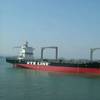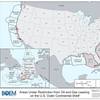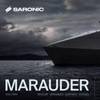Propulsion Update: Cat Debuts the C280
The 3600 series is a 280 mm-bore, medium-speed engine with a long track record in tugs, fishing vessels, tow boats, supply vessels, AHTS vessels, and military and patrol vessels. The C280 is designed for the same applications, available for either propulsion or auxiliary power. The new C280 incorporates all the core components of the 3600 series marine engine, including the cylinder block, crankshaft, connecting rods, pistons and camshafts, which have made it one of the most reliable and durable engines in its class.
The difference lies in the fuel injection, as the C280 replaces the mechanical fuel injection system of the 3600 series with Caterpillar’s Electronic Unit Injection (EUI) fuel system. The EUI fuel system, which combines the Caterpillar ADEM-III governor with electronic unit injectors, is designed to take the C280 to a new level of precision. Variable injection timing and duration optimize combustion for any given speed and load. This electronic fuel system is similar to the one utilized in the Caterpillar 3500B series.
Unlike many fuel injection systems, the Caterpillar EUI system does not employ high pressure fuel lines and therefore does not require threaded fuel connections or double-walled fuel lines. Rather, the system employs a low-pressure fuel supply. Injection pressure is created via a pump that is an integral part of the unit injector itself.
Each injector solenoid controls fuel delivery and eliminates the need for mechanical synchronization of the injectors. The ADEMä-III precisely controls each injector solenoid so the timing and the length of the injection are adjusted to match the specific load and speed requirements at any given moment. ADEM-III monitors the amount of boost pressure generated by the turbochargers and the throttle speed demanded and then dispenses just the right amount of fuel for an optimum combustion process.
ADEM-III also enables customer programmable features such as droop, gain, and fuel/air ratio control so the fuel system may be customized for each individual application, depending on the requirements.
By optimizing the combustion process, the C280’s EUI fuel system reduces part load fuel consumption, transient smoke and emissions. The C280 meets current EPA and IMO Tier I emissions standards and has the capability to meet future EPA and IMO Tier II emissions standards. Other C280 upgrades include:
- High-performance aftercoolers (HPAC) deliver cooler combustion air for longer valve life
- An anti-polishing ring in the cylinder liner prevents soot accumulation above the top piston ring land, which improves lube oil control and liner life
- For certain cyclical load applications, bi-metallic cylinder liners are employed to meet the rigors of these applications and to maintain long component life.
Early marine installations have been used to validate performance, with nearly 20,000 hours accumulated to date in applications such as line haul towing, harbor tugs, and tractor tugs. Feedback indicates that the C280 has virtually eliminated transient smoke, reduced steady state smoke, and lowered fuel consumption by as much as 11 percent in a line haul towing application.
“The C280 is a powerful and reliable marine workhorse, with electronic controls for improved performance. We’re receiving very positive reports from the field,” said Mike Mahn, Manager for Marketing Support, Caterpillar Marine Power Systems. “Also, our early installation customers have consistently reported less vibration and noise, and with today’s increased emphasis on crew comfort, they are very pleased about this.”
The C280 is available with continuous and maximum continuous ratings from 1730 -5420 bkW (2320-7270 bhp) for propulsion applications, and prime power ratings from 1900-5420 bkW (2550-7270 bhp) for marine auxiliary and diesel electric drive applications. Rated speeds of 900 or 1000 rpm may be selected for 6, 8, 12, and 16 cylinder configurations. Factory shipments are planned for mid-2005.






